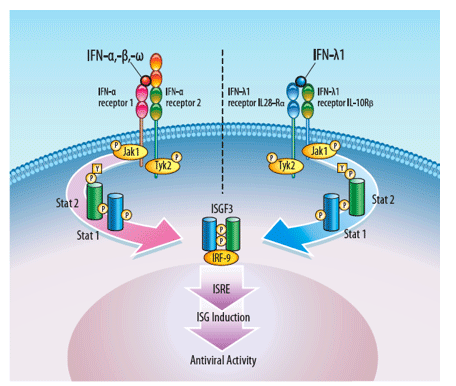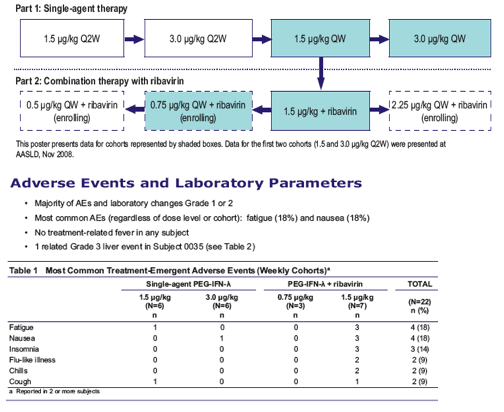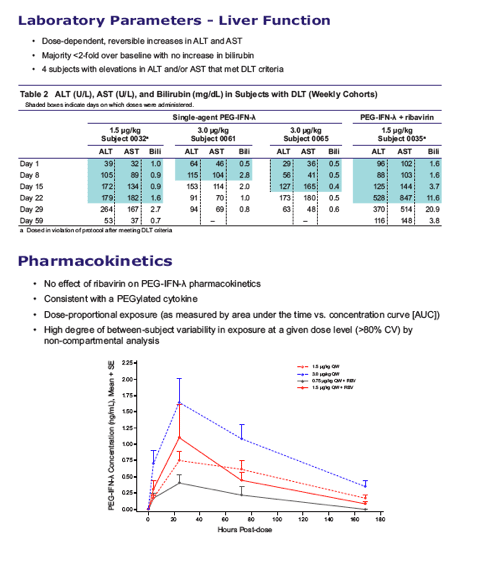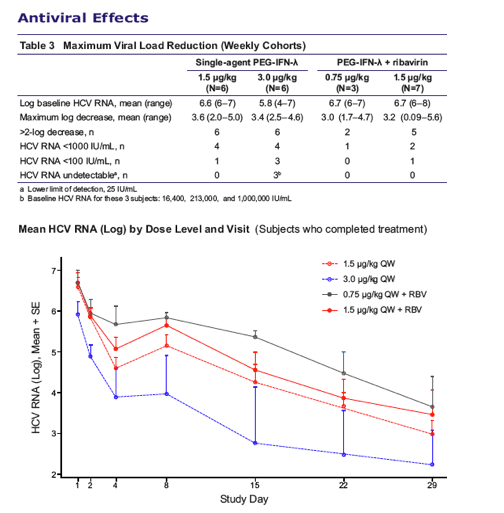 |
 |
 |
| |
Peg-Interferon lambda + Ribavirin 4 Weeks
|
| |
| |
EASL April 23-26 2009
Copenhagen, Denmark
Reported by Jules Levin
Bristol-Myers Squibb and ZymoGenetics Present Positive 4-week Results of PEG-Interferon lambda with Ribavirin in Hepatitis C
- PEG-Interferon lambda well tolerated in combination with Ribavirin -
- Mean maximum HCV RNA viral load decrease 3.0 logs or greater at all weekly dose levels -
EASL 2009 Annual Meeting
PRINCETON, N.J. & SEATTLE--(BUSINESS WIRE)--Bristol-Myers Squibb (NYSE:BMY) and ZymoGenetics, Inc. (NASDAQ:ZGEN), today reported that the administration of the investigational compound PEG-Interferon lambda in combination with ribavirin in 10 patients resulted in a significant reduction in hepatitis C virus (HCV) RNA and was well tolerated in patients with relapsed HCV in an ongoing Phase 1b clinical trial. Antiviral activity was observed at all dose levels tested either as single agent or in combination with ribavirin. Treatment was well-tolerated with reversible, dose-dependent increases in liver enzyme levels and bilirubin. There was no evidence for potentiation of ribavirin-induced toxicities in the combination groups. The interim results were presented at the European Association for the Study of the Liver (EASL) annual meeting in Copenhagen, Denmark.
"PEG-Interferon lambda showed antiviral effects as a single agent and also in combination with ribavirin. The lack of hematologic adverse effects in the trial is very encouraging," said Mitchell Shiffman, M.D., Virginia Commonwealth Medical Center.
The Phase 1b clinical trial was designed to evaluate the safety and antiviral activity of PEG-Interferon lambda as a single agent or in combination with ribavirin in genotype 1 HCV patients with relapsed disease. The single agent part of the study, designed to assess PEG-Interferon lambda administered subcutaneously either with a weekly or every other week dose-escalation schedule at 1.5 mcg/kg and 3.0 mcg/kg for four weeks, is complete. In the combination part of the study, data are available for the first 10 subjects who have received weekly subcutaneous administration of PEG-Interferon lambda at doses of 0.75 mcg/kg (3 patients) or 1.5 mcg/kg (7 patients) with daily oral ribavirin administered per the package insert over a four-week period.
Antiviral activity was seen in all cohorts, with a mean maximum decrease in HCV RNA viral load of at least 3.0 log10 in all single agent and combination cohorts receiving weekly dosing. Of the 22 patients dosed weekly, 86% showed a 2 log10 or greater decrease in HCV RNA at Day 29 and 50% had less than 1,000 HCV RNA copies. Of the six patients treated weekly with 3.0 mcg/kg single agent, 50% achieved a rapid virologic response (RVR; undetectable HCV RNA copies at 4 weeks).
PEG-Interferon lambda was well tolerated over four weeks of treatment with minimal hematologic effects or constitutional symptoms. No fever was reported. The majority of adverse events were Grade 1 or 2, the most common of which were fatigue (18%) and nausea (18%). Reversible, dose-dependent increases in liver enzymes (ALT, AST) meeting the protocol criteria for dose-limiting toxicity were observed in four patients, of which three also experienced reversible increases in bilirubin. There were no clinically significant changes in serum chemistry or renal function. Decreases in mean hemoglobin values occurred only in ribavirin cohorts, and there was no neutropenia.
PEG-IFN-λ: Antiviral Activity and Safety Profile in a 4-Week Phase 1b Study in Relapsed Genotype 1 Hepatitis C Infection
M.L. Shiffman1, E. Lawitz2, A. Zaman3, J. Vierling4, B. Yoffe4, S. Souza5, J. Freeman5, T. Gray5, D.F. Hausman5, A.J. Muir6
1 Virginia Commonwealth University Medical Center, Richmond, VA; 2 Alamo Medical Research, San Antonio, TX; 3 Oregon Health & Science University, Portland, OR; 4 Baylor College of Medicine, Houston, TX; 5 ZymoGenetics Inc, Seattle, WA, USA; 6 Duke University, Durham, NC, USA
SUMMARY & CONCLUSIONS
· PEG-IFN-λ was associated with robust antiviral activity at all dose levels tested in subjects with relapsed HCV
- 3 subjects with undetectable HCV RNA
· Dose-limiting toxicities were reversible elevations in ALT, AST, and bilirubin
- Elevations anticipated to be managable with dose modification
· Minimal constitutional symptoms and hematologic effects as single agent or
with ribavirin
Data support moving to dose-ranging Phase 2 in treatment-naive patients
ABSTRACT
Background: PEG-interferon-λ1a (PEG-IFN-λ/PEG-rIL-29) is a Type III interferon that binds to a unique receptor with a more limited distribution than the Type I interferon receptor. In a Phase 1 healthy volunteer study, PEG-IFN-λ was pharmacologically active without flu-like symptoms or hematologic side-effects. This ongoing Phase 1b study is evaluating the safety and efficacy of PEG-IFN-λ in patients with relapsed genotype 1 hepatitis C virus (HCV) infection.
Methods: Cohorts of 6 subjects each received 4-week treatment with subcutaneous PEG-IFN-λ every other week (Q2W) or weekly (QW), alone or with daily ribavirin. Assessments included adverse events (AEs), laboratory abnormalities, and measurements of HCV RNA.
Results: 18 subjects with a mean baseline log10 HCV RNA of 6.80 IU/L received PEG-IFN-λ alone (1.5 and 3.0-µg/kg Q2W, and 1.5-µg/kg QW). Antiviral activity (≥1-log10 decrease in HCV RNA) was observed in all cohorts.
QW dosing was associated with the most robust response at Day 29: 6/6 subjects achieved > 2-log10 decrease from baseline; 4/6 subjects had HCV RNA <1000 IU/L.
Treatment was well tolerated without hematologic toxicities or treatment-related fever. All AEs were Grade 1/2; the most common were fatigue (n=3) and myalgia (n=2). Most laboratory abnormalities were Grade 1/2; two subjects (1
each at 3.0-µg/kg Q2W and 1.5-µg/kg QW) experienced reversible Grade 3 aminotransferase elevations.
Conclusions: Repeated dosing with PEG-IFN-λ was well tolerated with minimal constitutional symptoms. In contrast to effects of Type I interferons, there were no significant decreases from baseline values in neutrophil or platelet counts. Maximal antiviral activity was achieved with weekly dosing. Results with single-agent PEG-IFN λ support further study in combination with ribavirin or other antiviral agents. Updated results from the PEG-IFN-λ + ribavirin cohorts will be presented at the meeting.

INTRODUCTION
PEG-Interferon Lambda 1a (PEG-IFN-λ; PEG-rIL-29)
· PEGylated recombinant human interferon (IFN)-λ1
· Member of the Type III/λ IFN familya
· Binds to a unique receptor with more restricted distribution than IFN-α/Type I IFN receptor
- Receptor not detected in bone marrow CD34+ progenitor cells
· In development as new treatment for chronic hepatitis C virus (HCV) infection
- Potential for more favorable side-effect profile than IFN-α and other Type I interferons, including
decreased hematologic toxicity

STUDY DESIGN
Objectives: Safety and Antiviral Activity
· Part 1: Single agent PEG-IFN-λ (subcutaneous [SC])
· Part 2: PEG-IFN-λ (SC) in combination with ribavirin
Population
· Genotype 1 infection
· Relapsed after treatment with PEG-IFN-α + ribavirin
· Alanine aminotransferase (ALT) and aspartate aminotransferase (AST)
2.5 °- upper limit of normal (ULN)
· No evidence or history of decompensated liver disease or cirrhosis
Treatment Regimen
· PEG-IFN-λ: Q2W (Days 1 and 15) or QW (Days 1, 8, 15, and 22)
- No dose modification allowed
· Ribavirin (Copegus): (Part 2 only) Daily (Days 1-28): 1000 mg (subjects <75 kg) or
1200 mg (subjects ≥75 kg)
On-Study Assessments
· Adverse events (AEs)
· Clinical laboratory evaluations
· HCV RNA
· Pharmacokinetics



Presentation Date: Apr 25, 2009
VIRAL KINETIC MODELING DURING TREATMENT WITH INTERFERON LAMBDA-1A IN GENOTYPE 1 CHRONIC HEPATITIS C PATIENTS
M.G. Dodds1, D.F. Hausman2, D.M. Miller1
1Preclinical Development, 2Clinical Development, ZymoGenetics, Inc, Seattle, WA, USA
Background and aims: Peginterferon lambda-1a (PEG-IFN-λ1a) is a novel Type III interferon that binds to a unique cell surface receptor and induces an intracellular antiviral response similar to that induced by IFN-α. As the expression of the IFN-λ receptor is more limited than the IFN-α receptor, we hypothesize that treatment of chronic hepatitis C (CHC) with PEG-IFN-λ1a will result in fewer toxicities and an improved therapeutic index.
As part of ongoing trial in treatment-relapsed chronic hepatitis C patients, changes in viral mRNA were analyzed using a mathematical model to assess the dose-response relationship of PEG-IFN-λ1a.
Methods: Models assuming constant drug effectiveness have been shown to successfully predict plasma HCV mRNA decline in patients after IFN-α therapy. One such model was fit to patient data from the following treatment cohorts: 1.5 mcg/kg PEG-IFN-λ1a QW with and without standard Ribavirin therapy for four weeks. The model describing viral mRNA concentrations over time after an initial rapid decline, V(t), is:
V(t)=(1-Δ)*V0*exp(-Δ*σ*t)
where V0 is pre-treatment viral mRNA concentration (copies/mL); Δ is the constant drug effectiveness (%); σ is the clearance rate constant of productively infected hepatocytes (1/day); t is time (day).
Results: Patient viral kinetics were compatible with the existing model previously developed for IFN-α's. In the cohort treated with 1.5 mcg/kg PEG-IFN-lλa alone QW for four weeks, constant drug effect estimates ranged from 45.3 to 98.6%, which are comparable to pegylated IFN-α therapy estimates. Data from later cohorts will be presented.
Conclusions: Model estimates after PEG-IFN-λ1a therapy are in agreement with IFN-α therapy estimates, supporting the idea of a common mechanism of action. Model estimates at well-tolerated doses of PEG-IFN-λ1a, as demonstrated in the ongoing clinical trial, are similar to reported pegylated IFN-α therapy estimates. More complex models that link drug serum concentration to effect (PK/PD models) are in development.
|
| |
|
 |
 |
|
|